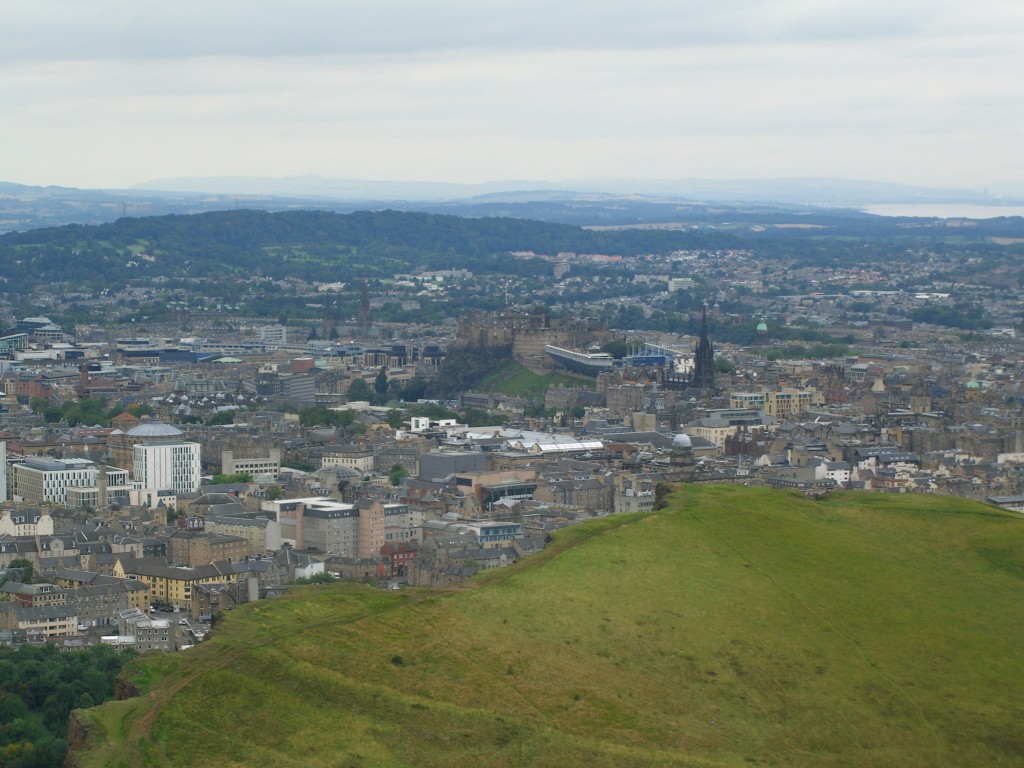If one can make sense of Vienna by an awareness of the historical presence of royal courts and the fact that Vienna was capital of the Holy Roman Empire for a while, one can make sense of Edinburgh by knowing about its nearly-constant battles throughout the centuries, as well as the fact that it was the center of the Scottish Enlightenment.
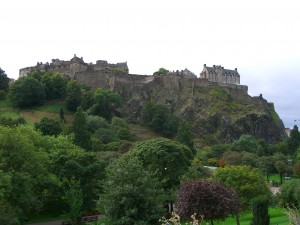 One of the very first things one is sure to see upon entering the city is the castle, an imposing structure built on, not just a mere hill, but a craggy precipice of rock that stands high above the rest of the town. It is all crags and cliffs except for one main road called the Royal Mile, which stretches down in a straight line eastward from the castle and reaches the Palace of Holyroodhouse. The palace is the Queen’s residence when in Scotland, and has always been the preferred residence of the royals since it was built, since the castle was for protection and afforded them few comforts.
One of the very first things one is sure to see upon entering the city is the castle, an imposing structure built on, not just a mere hill, but a craggy precipice of rock that stands high above the rest of the town. It is all crags and cliffs except for one main road called the Royal Mile, which stretches down in a straight line eastward from the castle and reaches the Palace of Holyroodhouse. The palace is the Queen’s residence when in Scotland, and has always been the preferred residence of the royals since it was built, since the castle was for protection and afforded them few comforts.
Adjacent to the palace is Holyrood Park, a large piece of land that was formerly used as royal hunting grounds. It contains springs, lakes, cliffs, and the highest point in all of Edinburgh – Arthur’s Seat.
Back westward we go to Castle Rock – on the north side, at the bottom of the cliffs, are beautifully tended gardens and the newer part of the city farther north. On the south side, nestled in the shadows of the dramatic rock face, is the oldest part of the city. Tiny shops line the narrow streets as well as restaurants, old churches, and graveyards.
Such is the general geography of the center of the city, and the part that Dave, Corzoo, and I had time to explore.
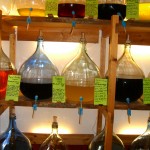 On our first afternoon, we wandered around the old part of the city, finding delightful shops – the world’s first liquid deli for instance. “What in the world is a liquid deli?” you might ask. Well, upon entering, you see large wooden casks and an array of clear vases with various colors of liquid in them. They contain oils, vinegars, liqueurs, and any other delight you can think of that might come in liquid form.
On our first afternoon, we wandered around the old part of the city, finding delightful shops – the world’s first liquid deli for instance. “What in the world is a liquid deli?” you might ask. Well, upon entering, you see large wooden casks and an array of clear vases with various colors of liquid in them. They contain oils, vinegars, liqueurs, and any other delight you can think of that might come in liquid form.
“What about chocolate milk?” Corzoo asked. I shook my head doubtfully. “Mango smoothies?” he tried again.
“I’m sorry,” said the very helpful shopkeeper. “but we only have things that keep a very long time. But we do have fun squiggly-shaped glass bottles that you can have after the older folks in your life finish up whichever liquid they choose to take home with them.”
We moved on to look at old bookshops, tweed stores, and an obligatory tartan shop before winding our way to Greyfriars Kirk and the kirkyard.
“Greyfriars Kirk? As in Captain Kirk?” Dave teased Corzoo with his Star Trek humor.
“No!” said the gullible little Corzoo. “Kirk means church! It is more visibly related to the German kirche. Remember that? It’s the word we have to be careful not to confuse with kirsche which means cherry!”
“Ah yes, I remember now!” Dave said. “I didn’t think I remembered James Tiberius Kirk having a brother named Greyfriars.”
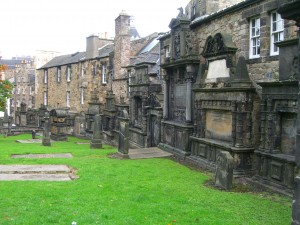 We wandered around the churchyard. If you can imagine the creepiest of Halloween movies you have seen with old, dark graveyards that harbor restless spirits and long-forgotten secrets – that is what Greyfriars kirkyard looks like! We found bars over some of the gravestones and wondered why in the world?
We wandered around the churchyard. If you can imagine the creepiest of Halloween movies you have seen with old, dark graveyards that harbor restless spirits and long-forgotten secrets – that is what Greyfriars kirkyard looks like! We found bars over some of the gravestones and wondered why in the world?
We discovered by reading a few plaques that Edinburgh went through a period of time where bodies would be stolen from graves to be used for study by medical students. People who were alive also had to be careful during this time. These body-snatchers weren’t averse to killing a person for the same purpose. YIKES!
We then moved on to a portion of the Royal Mile to explore and came across St. Giles Cathedral. It is an elaborate and very old church – some of the oldest portions date to the 12th century – and contains a small space called the Thistle Chapel.
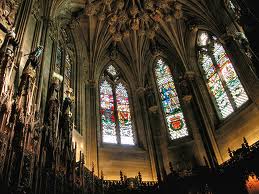 “Oooohhhhh!” cried Corzoo. “I was hoping I would get to see this chapel!”
“Oooohhhhh!” cried Corzoo. “I was hoping I would get to see this chapel!”
“Why?” we asked.
“It is the official meeting place of The Most Ancient and Most Noble Order of the Thistle,” he replied with a buzzy flourish.
“Well, I know what a thistle is and that it is the official flower of Scotland, but I don’t know what that Order is,” I said.
“I believe I can fill you in,” he said. “It is a chivalric order containing knights and ladies that have been appointed by the Sovereign – the Sovereign being whoever is king or queen at the moment. It was established by James VII of Scotland – most likely in order to secure the loyalties of certain politically strategic people. Nowadays the Queen (in this case) usually appoints people who have contributed in some great way to Scottish society.”
The chapel was small, but filled with detail and symbolism. Each of the sixteen knights and ladies has his or her own heraldry, or coat of arms, displayed above his or her seat. There were tiny carved animals on the each armrest between the seats – each one different. There were angels playing bagpipes and pelicans and, of course, thistles!
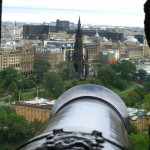 The next morning we visited the castle first thing. The views of the city from atop Castle Rock were impressive. We could see the entire city and beyond. It was very easy to see why one would choose the craggy rock for the castle location. We saw the crown jewels and the Stone of Destiny, which has been used in coronations for 1000 years. We went to the residential part of the castle called the Royal Palace where Mary Queen of Scots gave birth on June 19th, 1566 to James the VI of Scotland, who became James I of England. Upon seeing the accommodations, we understood immediately why the royals preferred Holyroodhouse as their residence. This was very barebones, indeed! We also visited the Great Hall, which displays brutal weapons of war – swords and spears and guns.
The next morning we visited the castle first thing. The views of the city from atop Castle Rock were impressive. We could see the entire city and beyond. It was very easy to see why one would choose the craggy rock for the castle location. We saw the crown jewels and the Stone of Destiny, which has been used in coronations for 1000 years. We went to the residential part of the castle called the Royal Palace where Mary Queen of Scots gave birth on June 19th, 1566 to James the VI of Scotland, who became James I of England. Upon seeing the accommodations, we understood immediately why the royals preferred Holyroodhouse as their residence. This was very barebones, indeed! We also visited the Great Hall, which displays brutal weapons of war – swords and spears and guns.
Underneath all of this were dungeons for prisoners of war. The stories that come from the castle would not make, in general, not very good bedtime stories. It was a place of war – not of peace – and as such, much suffering and violence took place there. However, it was especially interesting to see the old prison doors. Initials, names, and pictures were carved roughly into the wood. Ancient graffiti!
We also saw the sweet, tiny St. Margaret’s Chapel, which was built by King David in the year 1130, dedicated to his mother Margaret. It is the oldest surviving building in the entire city!
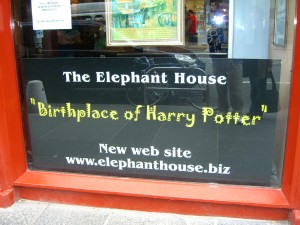 Dave’s concert was later that day, so we needed to get back and rest for a while, but before we did, we stopped in at The Elephant House for coffee and pastries. This is one of the cafés where J.K. Rowling began writing the first of her Harry Potter books. The back room of the café overlooks the creepy Greyfriars Kirkyard, all the winding streets of the old part of the city beneath, and looming above is the castle. It was easy to make the leap from the scene out of that window to the world of Hogwarts and all of the fantastical things that happened there!
Dave’s concert was later that day, so we needed to get back and rest for a while, but before we did, we stopped in at The Elephant House for coffee and pastries. This is one of the cafés where J.K. Rowling began writing the first of her Harry Potter books. The back room of the café overlooks the creepy Greyfriars Kirkyard, all the winding streets of the old part of the city beneath, and looming above is the castle. It was easy to make the leap from the scene out of that window to the world of Hogwarts and all of the fantastical things that happened there!
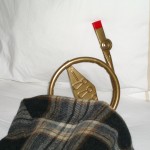 When we returned, our half-day of exploration had surprisingly worn us out. Corzoo decided it was time for a Scottish snooze, cuddled up in woolen tartan!
When we returned, our half-day of exploration had surprisingly worn us out. Corzoo decided it was time for a Scottish snooze, cuddled up in woolen tartan!
The following day was dedicated to the exploration of the Palace of Holyroodhouse and Holyrood Park.
“Ok, Tour Guide Corzoo,” I said. “What can you tell us about how such a magnificent structure as this came to be?”
Corzoo dove in eagerly to some historical information for us. “Well, the first thing to have been built on this site was actually an abbey whose ruins remain to this day. The legend is that King David had a vision here of a stag with a cross between its antlers. The king took this to be a sign and built an abbey dedicated to the Holy Rood. Rood means cross.”
Aha! I had wondered where such a funny word had come from.
“Really, the abbey and the adjacent hunting grounds – what is now Holyrood Park – were the most important things here for a very long time. But the royals’ guesthouse expanded into a more permanent residence and eventually became this exquisite palace. The abbey was partially destroyed by English raids in the 1500’s and by more mobs in the 1600’s, and since the design of roof of the abbey was faulty to begin with and seemingly irreparable, the ruins were finally left just as they were.”
“Thank you, Tour Guide Corzoo!” we said.
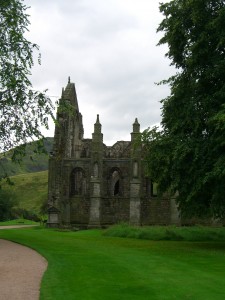 We walked through the magnificent, ornate palace. It was everything that the royal residences at the castle was not. It was comfortable, elaborate, and extremely beautiful. But our favorite part came when we walked out of doors off to the side of the palace. There before us stood the ruins of the abbey that King David had originally built. The ruins were nothing less than poetic.
We walked through the magnificent, ornate palace. It was everything that the royal residences at the castle was not. It was comfortable, elaborate, and extremely beautiful. But our favorite part came when we walked out of doors off to the side of the palace. There before us stood the ruins of the abbey that King David had originally built. The ruins were nothing less than poetic.
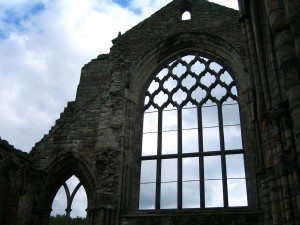 “Did you know,” said Corzoo, “that this is the place that gave Mendelssohn his inspiration for his third symphony, the Scottish Symphony?”
“Did you know,” said Corzoo, “that this is the place that gave Mendelssohn his inspiration for his third symphony, the Scottish Symphony?”
“Oh!” I exclaimed. “That makes a good deal of sense. I can see how he might hear that music while visiting here. It is such a melancholy place.”
We wandered around the abbey ruins for a while. Corzoo was whizzing around the abbey in a world of his own.
“What game are you up to, lad?” asked Dave.
“I am defending the abbey from the attackers. Watch out!!!” He made a lunge with his imaginary sword just to Dave’s side. “Whew, that was close. I saved you!”
“If I were King David instead of just Dave, I would bestow upon you knighthood of the Most Ancient and Most Noble Order of the Thistle.”
“Perhaps I will one day do something good enough and brave enough to be made a knight!” said Corzoo.
“I’m not sure it works that way, but perhaps you will,” answered Dave.
“What do you mean? Don’t most knights do very good and very brave things? I should be able to become one if I do many good and brave things, right?”
“Well, not to be a downer, small frye, but often the bravest of folks don’t get the knighthood their actions might warrant. And those who are knighted, well, they might be very good and very brave people indeed, and have done extraordinary things, but that doesn’t mean there aren’t those who are just as good and brave who – how do you say George Eliot puts it, Angela?”
George Eliot is one of my favorite authors. Mary Ann Evans was her real name. “She says they rest in unvisited tombs,” I replied.
“Yes – unvisited tombs!” he said.
“But I would rather be knighted and have a magnificent tomb – or better yet, never die and have no tomb at all!” said Corzoo.
“Well, yes, there is that, isn’t there,” said Dave.
“What is the point of being brave or good at all if I won’t be remembered as noble and recognized forever and ever by everyone?” Corzoo’s imaginary sword had dropped out of his hand, forgotten.
I tried to console him a bit. “There’s nothing to say you won’t be remembered by people and have recognition, but that can’t really be your aim now, can it? Otherwise you end up going about doing brave and ostentatious acts for the sake of looks. More harm can be done than good that way, and often you end up bumbling around like silly Don Quixote fighting his windmills.”
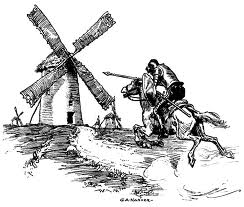 The reference to Don Quixote caused Corzoo to perk up a bit. Cervantes wrote many funny stories about the “ingenious gentleman” who wandered the country in search of adventures to prove himself a knight. He traveled on his skinny horse with his sidekick Sancho and declared the name of his lady-love before every “brave” act he committed. One of Corzoo’s favorite things was to listen to the very cheeky Strauss tone poem based on Don Quixote and his mis-adventures.
The reference to Don Quixote caused Corzoo to perk up a bit. Cervantes wrote many funny stories about the “ingenious gentleman” who wandered the country in search of adventures to prove himself a knight. He traveled on his skinny horse with his sidekick Sancho and declared the name of his lady-love before every “brave” act he committed. One of Corzoo’s favorite things was to listen to the very cheeky Strauss tone poem based on Don Quixote and his mis-adventures.
“You know, Corzoo, many people that we think of as being heroes are just very ordinary people, but they say that when put in a particular situation, they felt like they had no choice but to act in the way they did. Often, they wouldn’t have chosen to be put in that position in the first place!”
“Unlike Don Quixote who tried very hard to prove his knight-worthiness and ended up looking quite foolish,” Corzoo said.
“Exactly.” I replied. “I think that the ones who are real heroes are those who go quietly about their business tending to their ‘inner shining armor.’ The necessary actions flow quite naturally from them when the time comes. They have no choice but to do what they feel is right.”
“Hmmm, an inner shining armor…” I could see the image resonated with him and his spirits were lifting. “But how exactly does one tend to creating an inner shining armor? Just in case I have the opportunity to write a treatise on the philosophy of such things, you know.”
“Ahem, yes, of course,” I smiled at Corzoo’s sense of pride. “Well, I think perhaps it is a gentle and small thing that happens inside a person every single day,” I said. “Sometimes the bravest acts don’t look so brave on the outside – like putting oneself in someone else’s shoes and trying to understand the world through their eyes. Or acting in a peaceful way even though you want to retaliate….”
“That’s really difficult and gives me no satisfaction! And after all, an inner armor must have a sword along with it. What is the sword for?” said Corzoo.
“It’s for cutting through the crap!” Dave said.
“Succinctly put!” I replied. “It helps us see better – to get to the heart of things. To clear away the brush so we can see the proper path.”
We sat for a while, and wandered through the beautiful gardens of the Palace.
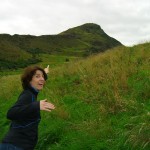 “Well, speaking of seeing things better,” I continued, “shall we go for our walk up to Arthur’s Seat?” I pointed to the peak of the large hill in front of us. “It will be good exercise and we’ll have excellent views of the entire city and even farther than that!” We were feeling a bit out of shape from sitting on planes and buses, but we huffed and puffed our way up.
“Well, speaking of seeing things better,” I continued, “shall we go for our walk up to Arthur’s Seat?” I pointed to the peak of the large hill in front of us. “It will be good exercise and we’ll have excellent views of the entire city and even farther than that!” We were feeling a bit out of shape from sitting on planes and buses, but we huffed and puffed our way up.
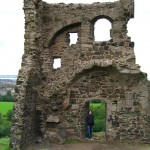 About a third of the way, we spotted more ruins. It was the ruins of St. Anthony’s Chapel overlooking St. Margaret’s Loch. Loch is the Scottish word for lake, Corzoo was sure to inform us. We inspected the ruins, and Dave pointed out the remnants of a fire someone had made in the corner of the ruins, and some ugly black graffiti people had left behind. It was apparently a favorite hang-out for many throughout the centuries.
About a third of the way, we spotted more ruins. It was the ruins of St. Anthony’s Chapel overlooking St. Margaret’s Loch. Loch is the Scottish word for lake, Corzoo was sure to inform us. We inspected the ruins, and Dave pointed out the remnants of a fire someone had made in the corner of the ruins, and some ugly black graffiti people had left behind. It was apparently a favorite hang-out for many throughout the centuries.
“Why did they mark up the ruins this way?” asked Corzoo.
I told him that my guess was that they figured they wouldn’t have a monument made for them after they died, so they wanted to leave traces of themselves behind in some way.
“Does it always come back to tombs with you?” Corzoo asked.
“Oh no, quite the contrary! But it does make sense, doesn’t it?” Corzoo had to agree with me. I determined not to mention tombs for the remainder of our outing. At least we weren’t talking about body-stealing like yesterday! But this was Edinburgh after all – a place that does creepy really well. It was okay to be just a little broody and dark.
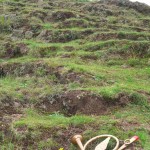 We walked on a gravel path most of the way, passing vast tangles of bushes and brambles and fields of thistles as well as gentle grassy knolls. Towards the top it got rockier and rockier. We were going to earn our view at the top! There were some moments where we had to be very careful with footing, walking along what was essentially a cliff with no barrier to keep from falling very far. But by keeping eyes fixed on where we were going rather than where we could have gone, we made it finally to the top. I helped Corzoo to get the best view possible of Castle Rock, the old part of the city, and as far as the Firth of Forth and beyond.
We walked on a gravel path most of the way, passing vast tangles of bushes and brambles and fields of thistles as well as gentle grassy knolls. Towards the top it got rockier and rockier. We were going to earn our view at the top! There were some moments where we had to be very careful with footing, walking along what was essentially a cliff with no barrier to keep from falling very far. But by keeping eyes fixed on where we were going rather than where we could have gone, we made it finally to the top. I helped Corzoo to get the best view possible of Castle Rock, the old part of the city, and as far as the Firth of Forth and beyond.
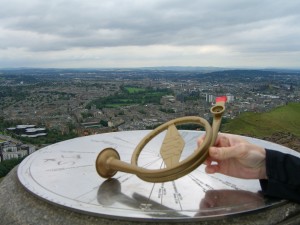 “I like it here,” said Corzoo. “Can we come back sometime and look around more?”
“I like it here,” said Corzoo. “Can we come back sometime and look around more?”
“I would absolutely love to,” I replied. “There are also many castles in the countryside too – those would be fun to see one day. And do you know, Corzoo, there is this thing called Scottish Country Dancing. With your love of movement, you just might like that dance!”
Did I hear a groan coming from Dave and sense an eye-roll?
“I shall watch you two from the sidelines with pleasure!” he said.
“Aw, com’on!” said Corzoo.
Off we went down the hill, debating the merits of dance, but in agreement about visiting this extraordinary city again some day.
